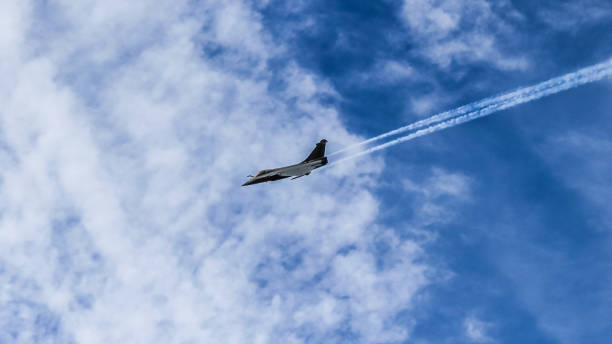Introduction
AESA (Active Electronically Scanned Array) radar technology has revolutionized air combat by offering superior detection, tracking, and engagement capabilities over older mechanically scanned radars. These radars are now standard in most modern fighter aircraft, including the F-22 Raptor, F-35 Lightning II, Rafale, Eurofighter Typhoon, and J-20. This article explores real-world and hypothetical scenarios where AESA radar plays a pivotal role in air combat operations.
1. Beyond-Visual-Range (BVR) Engagement
Scenario: Two opposing fighter jets—an F-35 and a legacy fourth-generation MiG-29—are flying in contested airspace. The F-35 uses its AN/APG-81 AESA radar to detect the MiG-29 at over 100 km, while remaining undetected due to its stealth features and low-probability-of-intercept radar emissions.
AESA Role:
-
Tracks multiple targets simultaneously.
-
Provides range, speed, and heading to cue long-range missiles like the AIM-120D AMRAAM.
-
Engages without visual contact, achieving a kill before the opponent is even aware.
2. Electronic Counter-Countermeasures (ECCM)
Scenario: A hostile aircraft uses radar jamming pods (e.g., ALQ-99) to disrupt friendly radar systems.
AESA Role:
-
Its frequency agility and beam steering capabilities allow it to "burn through" jamming.
-
Quickly switches frequencies to maintain lock on targets.
-
Retains tracking capability in dense electronic warfare (EW) environments.
Example: The F/A-18E/F Super Hornet, with its AN/APG-79 AESA radar, maintains radar contact even under heavy jamming.
3. Multiple Target Tracking and Engagement
Scenario: A Rafale confronts a mixed formation of drones and fighters approaching a defensive airspace.
AESA Role:
-
Tracks up to 40–60 targets at once (depending on radar model).
-
Can guide multiple missiles in-flight via Track-While-Scan (TWS) mode.
-
Increases kill probability by engaging threats in succession without interrupting surveillance.
Example: Rafale’s RBE2-AA AESA radar scans the airspace, prioritizes targets, and engages drones and fighters simultaneously.
4. Low-Observable or Stealth Aircraft Detection
Scenario: A Eurofighter Typhoon is deployed to detect a suspected J-20 stealth fighter approaching a strategic facility.
AESA Role:
-
Uses high-frequency L-band radar or integrates with other sensors (IRST, passive RF).
-
Combines high resolution with beam shaping to detect stealth aircraft from off-boresight angles.
-
Coordinates with AWACS or other fighters using data links like Link 16.
Example: The Typhoon’s CAPTOR-E AESA radar supports long-range stealth detection in a networked environment.
5. Maritime and Ground Attack Support
Scenario: A multirole fighter supports a naval strike group by scanning for low-flying cruise missiles or surface vessels.
AESA Role:
-
Sea and ground mapping via Synthetic Aperture Radar (SAR) modes.
-
Simultaneously detects air and surface threats.
-
Queues up air-to-ground weapons like JSOW or AASM bombs with precision.
Example: The Su-57’s N036 Belka AESA radar detects low-profile ships while maintaining air situational awareness.
6. Passive Targeting and Emissions Control
Scenario: A J-20 enters enemy airspace on a deep penetration strike mission, minimizing its radar signature.
AESA Role:
-
Can passively detect radar emissions from enemy aircraft.
-
Operates in Low Probability of Intercept (LPI) mode.
-
Reduces detectability while feeding real-time data into the pilot’s sensor fusion system.
Example: The J-20’s AESA radar collects targeting data passively, relaying it via encrypted datalink to another platform for engagement.
7. Cooperative Engagement and Networking
Scenario: An F-22 detects enemy fighters and shares tracking data with an F-35 and ground-based missile system.
AESA Role:
-
Serves as a sensor node in a distributed network.
-
Communicates through secure data links like MADL and Link 16.
-
Supports cooperative engagement capability (CEC), allowing one platform to launch a weapon and another to guide it.
Example: An F-35 spots a threat and guides a Patriot SAM battery on the ground to intercept it using fused AESA radar data.
Conclusion
AESA radar is not just a technological upgrade—it’s a game-changer in air combat. Its ability to detect, track, and guide weapons with precision across various mission profiles makes it indispensable for modern air forces. Whether engaging enemies BVR, defeating jamming, or integrating with other assets, AESA radar defines the cutting edge of air dominance.
Technical & Academic Sources
-
Northrop Grumman – AESA Radar Technology
-
Explains AESA fundamentals, LPI, multi-target tracking.
-
-
Raytheon Missiles & Defense – AN/APG-79 AESA Radar
-
Details AESA capabilities on the F/A-18 and EA-18G Growler.
-
https://www.raytheonmissilesanddefense.com/what-we-do/radar-and-sensors/apg-79
-
-
U.S. Department of Defense - F-35 Fact Sheet
-
Overview of AN/APG-81 AESA radar, its role in the F-35 sensor suite.
-
-
Jane’s Defence Weekly
-
Subscription-based resource but widely cited for data on radar ranges, aircraft capabilities.
-
-
Thales Group – RBE2 AESA Radar (Rafale)
-
Covers electronic scanning modes, range, and multi-target engagement.
-
-
Leonardo – CAPTOR-E Radar (Eurofighter Typhoon)
-
Describes the AESA radar upgrades for the Typhoon and combat scenarios.
-
-
Defense Update – Su-57 Belka Radar Suite
-
Technical overview of the Su-57's multi-band AESA system.
-
-
China Power Project – J-20 and J-10 Radars
-
Assessment of China's AESA radar development in modern fighters.
-
Books and White Papers
-
"Modern Fighter Aircraft Technology" by Martin Streetly
-
Covers radar evolution, including AESA radar in fifth-generation fighters.
-
-
NATO RTO Report on Radar Systems (RTO-EN-SET-133)
-
A thorough academic report detailing AESA radar advantages and limitations in operational use.
-







Comments
Post a Comment